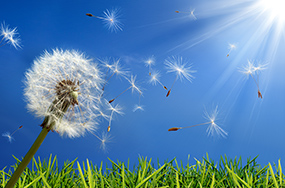Pollen Allergy, Also Known as Hay Fever, is One of the Most Common Allergies Affecting Americans
 Hay fever is one of the most common problems we see in our office, and is one of the most common chronic diseases in the United States.
Hay fever is one of the most common problems we see in our office, and is one of the most common chronic diseases in the United States.
It is caused by exposure to airborne pollen and causes 35 million people to suffer from allergy symptoms each year. The seasonal variety of pollen allergies is commonly referred to as hay fever (which has nothing to do at all with hay or with fever), but many doctors reserve this term for the specific allergy to ragweed which pollinates in the fall.
Allergies that occur from late March to June are usually due to tree allergies. Allergies that occur during the summer months are due to grass pollen allergy and patients who are having allergy symptoms in the fall are allergic to wheats and ragweed.
Each spring microscopic oval and circular tree pollen particles are released to hitch a ride on currents of air. Their mission is to fertilize other trees of the same species. Insects do this for some trees but for most the wind is relied on. Small, dry and light, pollen granules have been known to travel as far out as 400 miles out to sea and up to two miles high in the air. Because airborne pollens can travel so far, it does little good to remove the offending tree--pollen can drift in from miles away.
These lightweight wind carried pollens enter noses and throats to trigger allergic reactions characterized by irritation of the eyes, nose and throat. In more severe reactions lungs become affected as well.
Occasionally those with allergic reactions to tree pollens may also cross-react to certain raw fruits such as apples, plums and pears (though these foods may be less allergenic when cooked). Food cross-reactions are usually felt as itchiness in the mouth and throat.
Tree pollens generally show little cross reactivity among themselves. You must develop an allergy to each specific tree pollen in order for it to cause symptoms. If you are sensitive to oak, you are not necessarily allergic to cedar. There are two families of trees that are an exception to this; the family that contains oaks, beeches, and birches and the family belonging to the cedars and junipers. If you are allergic to the pollen of one of these trees, you will probably experience symptoms from one or more members of the same family.
Tree pollen counts tend to be higher on warm, dry and breezy days than during chilly, wet periods. Remain indoors when pollen counts are at their highest, particularly the early morning, late afternoon and early evening. Because of the microscopic size of tree pollens, most inexpensive masks sold at drug stores do not prevent pollen from sneaking in around the edges.
When "spring is in the air," grasses and flowers begin to revive, releasing copious amounts of pollen into the air in an annual ritual of survival. But survival for these plants means misery for many allergy and asthma sufferers. Seasonal allergies keep many people indoors in hopes of avoiding pollens. Indeed, staying indoors does reduce one's exposure, particularly if electrostatic air intake filters are used to keep the indoor environment clean. When going outdoors, remember that pollen levels are highest in the morning, and gradually subside as the day goes on.
Ragweed and hay fever have become synonymous in people's minds, especially during the cool fall months. Ambrosia is the scientific name given to ragweed, and it comes from the Latin term for "immortal." This certainly seems true, because attempts to eradicate this hearty plant have met with little success. Ragweed is a hairy, coarse looking plant that has no pretty flowers and it has an unpleasant smell. Its name was derived from the ragged appearance of its leaves. Short ragweed can bloom and spew pollen into the air when it's only a few inches tall, while the giant ragweed reaches twelve feet in height. Both thrive in soil that has been eroded or otherwise disturbed.
Another characteristic of ragweed is that the more hostile the growing environment, the more pollen a ragweed plant will produce. Stressful conditions and lack of rain shift the ragweed into a "procreation" mode; the plant then skimps on foliage and directs its resources into the bloom. Allergy sufferers can run, but they can't hide from ragweed, as the pollen can travel for miles on the breeze.
Dr. Ringwald offers the following tips:
- Remain indoors as much as possible during ragweed season. Pollen levels are highest in the morning hours.
- Take a brief shower after outdoor activities to remove pollen from the skin and hair.
- Keep windows up during automobile travel.
- It may be helpful to install electrostatic filters in place of the standard fiberglass air-intake filters.
- Click here to find out what the "Pollen Count" will be in your area. This pollen count information is useful because it will help you to know when to avoid staying outdoors too long when the pollen count is high.
There are options available other than 'shutting out the world.' New prescription antihistamines, decongestants, and anti-inflammatory medications can alleviate the severity of allergic rhinitis symptoms while having fewer side effects than medications of years past.
And finally, there is desensitization through immunotherapy (allergy shots). This method of treatment is effective in most individuals who suffer from severe allergies, and offers a lasting remedy to this seasonal problem.






